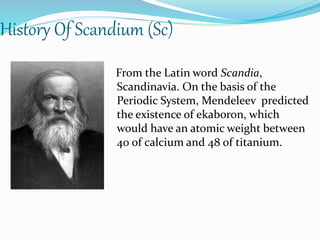Skandium - Inorganic Chemistry
•Download as PPTX, PDF•
0 likes•1,130 views
This ppt made by cosnert rabbani, student of chemist departement of andalas university, padang,Indonesia. Contact : Cosnertrabbani@gmail.com
Report
Share
Report
Share

Recommended
More Related Content
What's hot
What's hot (20)
Review Of Naming Compounds And Balancing Equations 1205854412907095 2

Review Of Naming Compounds And Balancing Equations 1205854412907095 2
Review Of Naming Compounds And Balancing Equations

Review Of Naming Compounds And Balancing Equations
Silicates, classification of silicates Zeolites,application of zeolites

Silicates, classification of silicates Zeolites,application of zeolites
Unit b matter and chemical change notes(compounds & properties)

Unit b matter and chemical change notes(compounds & properties)
Similar to Skandium - Inorganic Chemistry
Similar to Skandium - Inorganic Chemistry (20)
cbse-class-10-science-notes-chapter-3-metals-and-non-metals.pptx

cbse-class-10-science-notes-chapter-3-metals-and-non-metals.pptx
General principles and processes of isolation of elements

General principles and processes of isolation of elements
Metal-and-Non-metal-10 BEST FOR CBSE STUDENTS.pptx

Metal-and-Non-metal-10 BEST FOR CBSE STUDENTS.pptx
Recently uploaded
https://app.box.com/s/tkvuef7ygq0mecwlj72eucr4g9d3ljcs50 ĐỀ LUYỆN THI IOE LỚP 9 - NĂM HỌC 2022-2023 (CÓ LINK HÌNH, FILE AUDIO VÀ ĐÁ...

50 ĐỀ LUYỆN THI IOE LỚP 9 - NĂM HỌC 2022-2023 (CÓ LINK HÌNH, FILE AUDIO VÀ ĐÁ...Nguyen Thanh Tu Collection
https://app.box.com/s/4hfk1xwgxnova7f4dm37birdzflj806wGIÁO ÁN DẠY THÊM (KẾ HOẠCH BÀI BUỔI 2) - TIẾNG ANH 8 GLOBAL SUCCESS (2 CỘT) N...

GIÁO ÁN DẠY THÊM (KẾ HOẠCH BÀI BUỔI 2) - TIẾNG ANH 8 GLOBAL SUCCESS (2 CỘT) N...Nguyen Thanh Tu Collection
Recently uploaded (20)
Students, digital devices and success - Andreas Schleicher - 27 May 2024..pptx

Students, digital devices and success - Andreas Schleicher - 27 May 2024..pptx
The Art Pastor's Guide to Sabbath | Steve Thomason

The Art Pastor's Guide to Sabbath | Steve Thomason
Forest and Wildlife Resources Class 10 Free Study Material PDF

Forest and Wildlife Resources Class 10 Free Study Material PDF
50 ĐỀ LUYỆN THI IOE LỚP 9 - NĂM HỌC 2022-2023 (CÓ LINK HÌNH, FILE AUDIO VÀ ĐÁ...

50 ĐỀ LUYỆN THI IOE LỚP 9 - NĂM HỌC 2022-2023 (CÓ LINK HÌNH, FILE AUDIO VÀ ĐÁ...
The Benefits and Challenges of Open Educational Resources

The Benefits and Challenges of Open Educational Resources
GIÁO ÁN DẠY THÊM (KẾ HOẠCH BÀI BUỔI 2) - TIẾNG ANH 8 GLOBAL SUCCESS (2 CỘT) N...

GIÁO ÁN DẠY THÊM (KẾ HOẠCH BÀI BUỔI 2) - TIẾNG ANH 8 GLOBAL SUCCESS (2 CỘT) N...
INU_CAPSTONEDESIGN_비밀번호486_업로드용 발표자료.pdf

INU_CAPSTONEDESIGN_비밀번호486_업로드용 발표자료.pdf
Salient features of Environment protection Act 1986.pptx

Salient features of Environment protection Act 1986.pptx
Basic Civil Engg Notes_Chapter-6_Environment Pollution & Engineering

Basic Civil Engg Notes_Chapter-6_Environment Pollution & Engineering
Skandium - Inorganic Chemistry
- 1. History Of Scandium (Sc) From the Latin word Scandia, Scandinavia. On the basis of the Periodic System, Mendeleev predicted the existence of ekaboron, which would have an atomic weight between 40 of calcium and 48 of titanium.
- 3. EKA-BORON The name given by Mendeleyev in accordance with the periodic law, and by prediction, to a hypothetical element then unknown, but since discovered and named scandium. so called because it was a missing analogue of the boron group.
- 4. The element was discovered by Nilson in 1878 in the minerals euxenite and gadolinite, which had not yet been found anywhere except in Scandinavia. euxenite and gadolinite is sources of this element
- 5. Properties Scandium is a silver-white metal which develops a slightly yellowish or pinkish cast upon exposure to air. A relatively soft element, scandium resembles yttrium and the rare-earth metals more than it resembles aluminum or titanium. It is a very light metal and has a much higher melting point than aluminum, making it of interest to designers of spacecraft.
- 6. Source Scandium is apparently much more abundant (the 23rd most) in the sun and certain stars than on earth (the 50th most abundant). It occurs as a principal component in the rare mineral thortveitite, found in Scandinavia and Malagasy. It is also found in the residues remaining after the extraction of tungsten from Zinnwald wolframite.
- 7. How to extrat skandium? Pure scandium metal can be made by reacting scandium fluoride (ScF3) with another active metal, such as calcium or zinc, eg, 3Ca + 2ScF3 3CaF2 + 2Sc
- 8. Reaction Reaction of scandium with air Scandium metal tarnishes in air and burns readily to form scandium (III) oxide, Sc2O3. 4Sc + 3O2 → 2Sc2O3
- 9. Reaction of scandium with water When finely divided, or heated, scandium metal dissolves in water to form solutions containing the aquated Sc(III) ion together with hydrogen gas, H2. 2Sc(s) + 6H2O(aq) → 2Sc3+(aq) + 6OH-(aq) + 3H2(g)
- 10. Reaction of scandium with the halogens Scandium is very reactive towards the halogens fluorine, F2, chlorine, Cl2 bromine, Br2, and iodine, I2, and burns to form the trihalides scandium(III) fluoride, ScF3 , scandium(III) chloride, ScCl3, scandium(III) bromide, ScBr3, and scandium(III) iodide, ScI3 respectively. 2Sc(s) + 3F2(g) → 2ScF3(s) 2Sc(s) + 3Cl2(g) → 2ScCl3(s) 2Sc(s) + 3Br2(g) → 2ScBr3(s) 2Sc(s) + 3I2(g) → 2ScI3(s)
- 11. Application About 20 kg of scandium (as Sc2O3) are used yearly in the U.S. to produce high-intensity lights. The radioactive isotope 46 Sc is used as a tracing agent in refinery crackers for crude oil, etc. Scandium iodide added to mercury vapor lamps produces a highly efficient light source resembling sunlight, which is important for indoor or night-time color TV.
- 12. Continue.. The original use of scandium-aluminium alloys was in the nose cones of some Soviet submarine-launched ballistic missiles (SLBM). Scandium alloys are especially desirable for use in, for example, baseball bats, lacrosse sticks, and bicycle frames. Fuel cells
